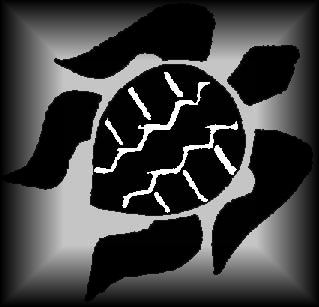
The Kefalonian Marine Turtle Project
 |
The Kefalonian Marine Turtle Project |
Current Research
This page outlines the basics of our current research and findings on the loggerhead turtles of Kefalonia.
General Population Information
Scientific objectives for 1998 and beyond
Links between Sea Turtle By-catch and tagging around Kefalonia
Nesting site fidelity in Loggerhead Sea Turtles - Kefalonia
Field research into the loggerhead turtle (Caretta caretta) population of Kefalonia has been carried out since 1984. This work has centred primarily around population dynamics and morphometrics of this species and has resulted in some related publications. The most notable contributions have arisen from the work of Hays (1992), Hays & Speakman (1991; 1992; 1993) and Hays et al (1991). One of the aims of the KMTP is to increase the availability of data and findings (in the form of publications) for use in local and international studies. This aim is being met by the improvement and realisation of scientific thought and procedure.
INTRODUCTION:
THE POPULATION OF SEA TURTLES
ASSOCIATED WITH KEFALONIA
The use of the southern beaches of Kefalonia for nesting by long been Caretta caretta has documented (MTRP, 1993, nesting unpubl.). However, limitations in the monitoring of the environment has ultimately led to an underestimate in the number of nesting females. Monitoring of all beaches on the south of the island was introduced in 1997.
Most research, however, is carried out on the 2.7km Mounda beach, south-east Kefalonia. To date a total of 139 female Caretta caretta have been witnessed to nest on Mounda beach. The number of nests each season, and respective females can be seen in Figures 1 (a) and (b) below.
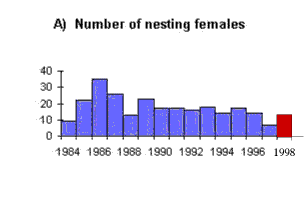
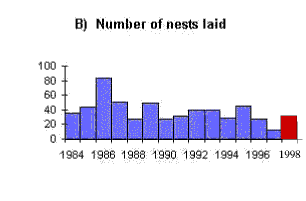
Figure 1. The number of Caretta caretta (a) nesting females, (b) nests, (c) adult emergences, and (d) % of successful nesting emergences monitored on Mounda beach, Kefalonia, between 1984 and 1997.
From these graphs it is evident that the numbers of females visiting Mounda beach has varied greatly over the years of monitoring. Such fluctuations are widespread, and have been found in Florida (Owen et al, 1992; Bagley et al. 1995; Ehrhart et al, 1996), Surinam (Schultz, 1995), Australia (Limpus, 1995), Malaysia (Limpus, 1995b) and the pacific islands (Balazs, 1995). This may be attributable to the long inter-nesting period of loggerhead turtles estimated at two to three years. This infers that the high numbers consist of the same individuals returning, and those present in the 'low' years are either exhibiting a longer cycle or are out of synchrony with the rest of the population. Furthermore, there is cause for concern that long term population declines or increases may be masked by such population oscillations (Pritchard, 1995 b)
SCIENTIFIC OBJECTIVES FOR 1998 AND BEYOND
Observing the movements
of sea turtles
Population morphometrics
Nesting behaviour
Reproductive investment
Study of parasitic and commensal organisms
The nest environment
Reasons for egg failure and development mortality
Hatchling emergence
Behaviour of hatchlings in response to light
Foraging surveys
1. Observing
the localised movements of sea turtles
In 1998 an investigation was devised to look at localised movements of sea turtles
around Kefalonia during the inter-nesting period. As such, extensive validation
trials were carried out on 3 radio transmitters (Advanced Telemetry Systems,
USA) to test their applicability to sea turtle research. These trials proved
highly successful and served as the forerunner for the deployment of the transmitters
on 3 nesting females on Mounda beach. The data received is currently under analysis,
and will be combined with data from the proposed redeployment in summer 1999.
2. Populations
morphometrics
It has been well documented that size/age relationships between different geographically
separated populations varies significantly (e.g. Dodd, 1988). Until now, measurements
of carapace dimensions taken on Kefalonia have only been used in determining
the relationship between size and fecundity (Hays and Speakman, 1991). Previous
carapace measuring techniques are possibly too insensitive to measure carapace
growth increments. Consequently, the system of measurement was improved in the
1997 season, by increasing the number and type of measurements taken, thereby
reducing variability, which will allow for the determination of growth curves
for comparison with other populations within the Mediterranean and further afield.
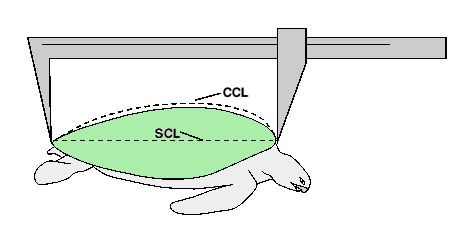 Figure 2. Carapace measurements. CCL = curved carapace length; SCL =
straight carapace length. (Graphics courtesy of R. H. C. Poland, EuroTurtle)
Figure 2. Carapace measurements. CCL = curved carapace length; SCL =
straight carapace length. (Graphics courtesy of R. H. C. Poland, EuroTurtle)
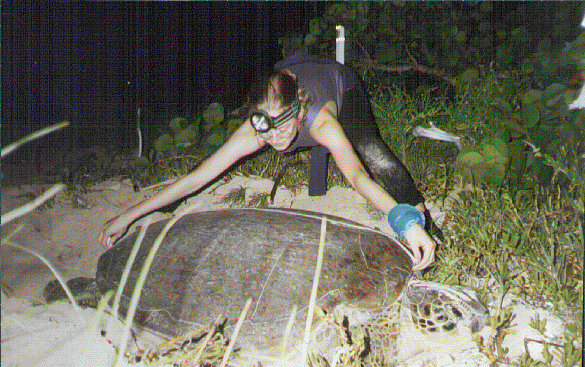
3. Nesting behaviour
One of the most hotly debated questions in turtle biology is 'what determines
the placement of a nest within an apparently homogeneous beach?'. There are
many physical parameters that may influence nest placement and we have chosen
to focus on sand temperature, water content, grain size and beach morphology.
The results of this investigation are currently under analysis and should be
ready in the near future.
4. Reproductive Investment
During a given nesting event, numerous variables are measured; for example clutch
size, clutch volume, the duration of nesting stages and the number of nesting
attempts. It is important to have data on such factors in order to determine
how they relate to morphology and foraging ecology.
5. Study of the
parasitic and commensal organisms associated with Caretta caretta
Studies carried out on commensal organisms may offer some clues as to the geographical
distribution of their hosts. The KMTP has collected qualitative and quantitative
data of epiphytic organisms associated with nesting females since June 1995.
Checks for fractures and lacerations are also carried out to identify any anthropogenic
or predatory injuries incurred in the marine environment.
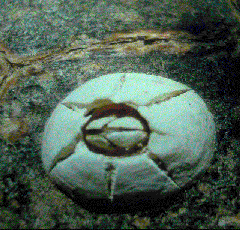
Figure 4. Giant barnacle found on loggerhead turtle. (Photo: R. H. C. Poland, EuroTurtle)
6. The Nest Environment
It is important to understand the environmental conditions to which any given
clutch is subjected during its developmental stages. This can play an important
role in the studies of egg viability, development mortality and population reproductive
dynamics. During 1998 in-nest data loggers (Tinytalk II) were deployed in a
number of nests on Mounda beach. The data retreived now forms the basis of predictive
work on sex ratios within nests and studies on the atypical hatching/emergence
patterns charactersitc of Kefalonia.
On Kefalonia, the success of a given nest is determined by post-hatching nest excavations. Data obtained by this technique have been combined with spatial and temporal descriptions of nest environments for the past three years.
7. Reasons
for egg failure and development mortality
The early stages of embryonic development represent a crucial
period in the life history of sea turtles. An array of biotic and abiotic factors
contribute to high levels of egg failure and development mortality (Richardson
& Richardson, 1981; Stancyk, 1981). Studies of nests have shown that many
eggs fail to hatch (e.g. Fowler, 1979); 12% of egg failures in nests laid on
Mounda beach in 1995 were due to infertility (Houghton, 1995).
Our investigation aims to ascertain the relationship between reproductive success within sea turtle nests and the numerous physical, chemical and biological factors which affect it.
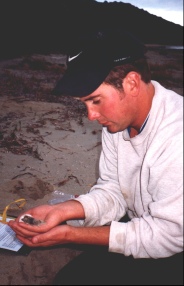
Figure 5 Examining the contents of an extinct nest (J. Houghton)
8. Hatchling
emergence
Intermittent emergence from nests of up to four days has been reported amongst
several populations, e.g. in Zakynthos (Hudson pers. comm.,1996) and
in Florida (Witherington et al., 1990). However, on Kefalonia the period
of emergence can last up to 20+ days. Recent studies using "in-nest" data loggers
have related this to temperature ranges within nests and its subsequent effect
upon incubation periods i.e. the greater the temperature range between the top
and bottom of an egg chamber, the greater the period of hatching.
9. Behaviour
of hatchlings in response to light
The orientation behaviour exhibited by hatchlings finding the sea
has been well studied. The KMTP is currently studying the mis- and dis-orientation
of hatchlings emerging from their nests on Mounda beach against variations in
their natural environment. Results will be related to the impact of artificial
light and conservation practices.
The basic patrol routine
on Mounda beach
Patrol routines on other southern and western shores
Beach and nest marking
A detailed description of the scientific codes and procedures performed since 1997 can be found in Suggett et al (1997), and only a brief outline will be given here. These procedures are essentially a combination of those that have evolved with use on Kefalonia, in addition to an adaptation of procedures employed by other research projects.
The
basic patrol routine on Mounda Beach (nesting season)
The centre of Mounda beach is used as the starting point; turtle emergences
are rare in this area due to the rocky outcrop just offshore, and it splits
the beach into halves of similar distance (the western end, 'Kaminia' and the
eastern end, 'Potamakia'). The beach is monitored between 21.00hrs and 07:00hrs
during the adult season. A total of approximately 1400 hours (138 nights)
monitoring time is put in by the project volunteers throughout a season.
Volunteers are divided into 3 groups (depending on numbers). One group remains in the centre to meet any late visitors to the beach and to continue the patrols should a turtle be found by another group. The other volunteers patrol to the ends of the beach, walking quickly, quietly, and without torches at the waters edge, checking both seaward and for tracks. Volunteers wait for 20 minutes on arrival at the end of the beach, and then patrol back to the middle. The beach is patrolled fully every 25 minutes. The final run takes place around dawn, when any nests were thoroughly marked. This method strikes a balance between over-patrolling which may deter any potential nesting females from coming ashore, and under-patrolling whereby data may be missed.

Figure 6. Distinctive turtle tracks. (Photo: R. H. C. Poland, EuroTurtle)
Patrol routines
on other southern and western shores
The entire southern and western shores were surveyed during 1997.
Throughout that season (June to the end of August), the coast was surveyed for
nesting activity. Each beach was visited once a week via land or sea (depending
on beach accessibility), with any activity categorised according to successful
nesting or non-nesting emergence (unsuccessful nesting attempt(s); false crawl/U-turn).
These beaches will continue to be monitored, but more regularly.

Figure 7. Map outlining coastal areas of Kefalonia, where surveying showed turtle activity. Numbers indicate total number of emergences (number of nesting emergences). Taken from Houghton et al (1997).
Beach and Nest marking
At the start of each season, the beach is measured from Mounda point to
the rocks at the far end of Kaminia along the curved path of the vegetation
line. The vegetation line represents the only realistically stable landmark
on the beach. At 50m intervals a straight measurement is taken to the high water
mark and then to the waters edge. The positions of prominent natural and man-made
features are plotted on a map. At 15m intervals starting from Mounda point,
beach markers (labelled strips of plastic yellow tape) are positioned on shrubs
at the vegetation line. From these points a triangulation can be taken to each
turtle nest, and distances recorded.
In the past this method has proved to be reliable when relocating turtle nest, however a more rigorous method of beach marking is being devised at present.
If readers of this page wish to contact the KMTP, they can do so via
or
phone/fax (+44) 1983 740321, or by post (see below).
The Kefalonian Marine Turtle ProjectThe
Kefalonian Marine Turtle Project is a Limited Company with Charitable Status
(registered in England and Wales, No 1062312).
Copyright 1998, KMTP. All Rights Reserved. Permission is granted by the KMTP for classroom supervisors/teachers and students to make reprographic copies of worksheets for non-commercial use. This permission does not extend to copying for promotional purposes, creating new collective works, or resale.